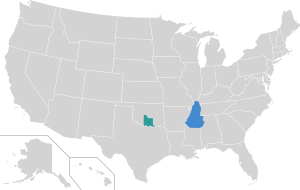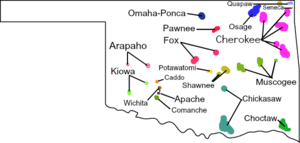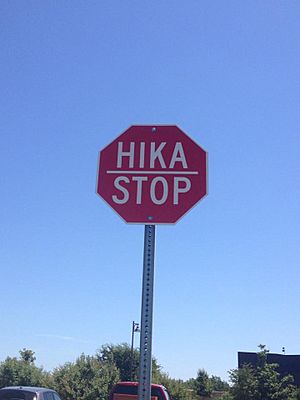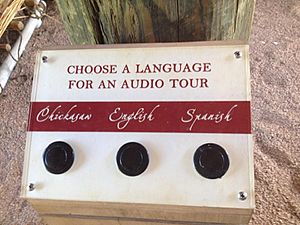Chickasaw language facts for kids
Quick facts for kids Chickasaw |
||||
|---|---|---|---|---|
| Chikashshanompa' | ||||
| Native to | United States | |||
| Region | South central Oklahoma, from Byng or Happyland (near Ada) north, and from Davis or Ardmore west to Fillmore and Wapanucka in east. | |||
| Ethnicity | 35,000 (1999) | |||
| Native speakers | 75 (2017)e21 | |||
| Language family |
Muskogean
|
|||

Historical (blue) Chickasaw territory and current (teal) Chickasaw territory (Chickasaw Nation), where the language was and is currently spoken
|
||||

Distribution of Native American languages in Oklahoma
|
||||
|
||||
The Chickasaw language (called Chikashshanompa' by its speakers) is a Native American language. It belongs to the Muskogean language family. This language builds words by adding many small parts, like LEGO bricks. It also follows a special word order: the subject comes first, then the object, and finally the verb (SOV).
The Chickasaw language is very similar to the Choctaw language. It is spoken by the Chickasaw tribe. Today, most Chickasaw people live in Southeast Oklahoma, especially around Ada.
Only about 50 people speak Chickasaw today. Most of these speakers are elders who grew up using the language. In the 1800s, the Chickasaw people were forced to leave their homeland in Mississippi. Later, in the 1900s, many children were sent to American Indian boarding schools. These events caused fewer people to learn and speak the language.
However, there is good news! More and more resources are becoming available to learn and save the Chickasaw language. Many people are now interested in learning and teaching it. The Chickasaw Nation even has helpful online tools to learn the language.
Contents
The Chickasaw Language Family
The Chickasaw language is part of the Muskogean language family. It forms the Western branch of this family, along with Choctaw and Houma. Long ago, the Chickasaw and Choctaw tribes were one group. They both spoke languages from the Muskogean family.
The Chickasaw language was widely spoken until the 1970s. Since then, it has become an endangered language. This means very few people still speak it. Other languages related to Chickasaw include Alabama, Koasati, Mvskoke (Creek)-Seminole, Hitchiti, and Mikasuki.
A Look at Chickasaw History
Before Europeans arrived, the Chickasaw people lived west of the Mississippi River. They later moved east and settled mostly in what is now northeast Mississippi. Chickasaw towns were built close together during wartime. But when there was peace, they spread out more.
A main house and meeting ground were central to their communities. People gathered there for ceremonies, celebrations, and important discussions. Men prepared for war, hunted for food, and defended their homes. Women took care of the home, farmed, and raised families.
Over time, the Chickasaw people met European explorers and traders. They had relationships with the French, English, and Spanish during the colonial period. The United States government called the Chickasaw one of the Five Civilized Tribes. This was because the Chickasaw adopted many ways of life from European Americans.
Even so, American settlers kept moving onto Chickasaw lands. The U.S. government forced the Chickasaw to sell their land in 1832. They had to move to Indian Territory (which is now Oklahoma) in the 1830s. This sad time is known as the Indian Removal era.
Saving the Chickasaw Language

The last person who spoke only Chickasaw, Emily Johnson Dickerson, passed away in 2013. In 2017, it was estimated that only about 75 people still spoke Chickasaw. Most of these speakers are 50 years old or older. Sadly, children are not learning the language at home anymore. This means the language is in great danger of disappearing.
By 2014, only "four to five confident conversational speakers" were under 35 years old. The Chickasaw language is not used much outside of homes. Experts say Chickasaw is a "severely endangered" language. Almost all of the ~50 speakers (as of 2019) also speak English.
Programs to Help the Language
The Chickasaw Language Revitalization Program started in 2007. It uses different ways to write Chickasaw words. Since Chickasaw is mainly a spoken language, there is no single "right" way to spell every word.
The language is taught through several programs:
- A "master-apprentice program" where experienced speakers teach new learners.
- Community programs for everyone to join.
- Self-study programs for people to learn on their own.
There is even a "Chickasaw Language Basic" app! You can find it for iPhone, iPad, and other iOS devices.
Classes and Learning Opportunities
The Chickasaw Nation has a special department for the Chickasaw Language. This department has a committee of 24 members who work to save the language. In 2007, they started the Chickasaw Language Revitalization Program.
You can take four levels of Chickasaw language classes at East Central University in Ada, Oklahoma. Joshua D. Hinson, who is called "Lokosh" (meaning gourd) in Chickasaw, leads the Chickasaw Language Committee. He created the master-apprenticeship programs with help from a language expert named Leanne Hinton.
Chipota Chikashshanompoli is a language program just for children. It meets once a month. Adult language classes are also held in many towns like Ada, Ardmore, Norman, Purcell, Sulphur, and Tishomingo. The tribe also organizes special "immersion camps." These camps help people learn the language by using it all the time. The Chickasaw Press also publishes books in the Chickasaw language.
Recently, the Chickasaw Language Revitalization Program teamed up with Rosetta Stone. They released a video series to teach people how to speak Chickasaw. This uses the Rosetta Stone Advanced Languages software.
Common Chickasaw Words
Here are some common words and phrases in Chickasaw:
| English | Chickasaw |
|---|---|
| Hello (general greeting) | Chokma/Hallito |
| How are you? | *Chinchokma?
|
| I'm well.
I'm very well. I'm alright. I'm not well. |
* Anchokma.
|
| And you? (In response) | Ishnaako? |
| Yes
No Okay |
* Ii
|
| I will see you later. | * Chipisala'cho. (This means "I'll see you later," but you don't know when.)
|
| I like ___.
He/she likes ___. You like ___. We like ___. They like ___. Y'all like ___. Do you like ___? |
Let's use hattak shawi' imimpa' (bananas) as an example.
|
Animals in Chickasaw
Many of these animals were important in Chickasaw culture and beliefs.
| English | Chickasaw |
|---|---|
| Deer | Issi' |
| Panther | Kowishto' |
| Wildcat | Kowimilhlha' or kowi' imilhlha' |
| Raccoon | Shawi' |
| Bird | Foshi' |
| Alligator | Hachonchaba' |
| Bear | Nita' |
| Fox | Chola |
| Turtle | Loksi' |
| Skunk | Koni' |
| Wolf | Nashoba |
| Fish | Nani' |
| Squirrel | Fani' |
| Blackbird | Chalhlha |
| Buzzard | Shiiki |
| Hawk | Akankabi' |
| Eagle | Osi' |
| Duck | Fochosh |
| Goose | Shalaklak or hancha' |
| Swan | Ookak |
| Turkey | Chaloklowa' |
Colors in Chickasaw
In Chickasaw, most color words end with a glottal stop (') when they are used with a noun. For example, foshi' homma' means "red bird."
| English | Chickasaw |
|---|---|
| Yellow | Lakna |
| Red | Homma |
| Pink | Hommayyi |
| Green/Blue | Okchamali |
| Brown | Losayyi |
| Orange | Takolo lakna |
| Purple | Homma chommi |
| Gray | Shobbokoli |
| Black | Losa |
| White | Tohbi |


